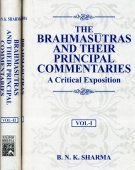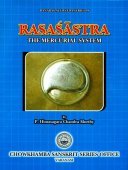Parabrahman, Parabrahmā, Parabrahma, Para-brahman: 15 definitions
Introduction:
Parabrahman means something in Hinduism, Sanskrit, the history of ancient India. If you want to know the exact meaning, history, etymology or English translation of this term then check out the descriptions on this page. Add your comment or reference to a book if you want to contribute to this summary article.
In Hinduism
Pancaratra (worship of Nārāyaṇa)
Source: Hindupedia: Ahirbudhnya SaṃhitaPara-brahman, the Absolute, is the highest Truth. He is the One, without beginning or end, all-pervading, free from all blemishes, full and perfect. He resides in all beings and is called Nārāyaṇa. His real nature can be experienced only in the state of liberation, which again is possible only by His grace and not by one’s own efforts.

Pancaratra (पाञ्चरात्र, pāñcarātra) represents a tradition of Hinduism where Narayana is revered and worshipped. Closeley related to Vaishnavism, the Pancaratra literature includes various Agamas and tantras incorporating many Vaishnava philosophies.
Purana and Itihasa (epic history)
Source: archive.org: Puranic EncyclopediaParabrahman (परब्रह्मन्).—The Supreme Spirit. General information. Brahman is the root cause of this universe. From Brahman originated Ākāśa (sky). From sky came air, from air came Agni and from Agni came water and from water was born this earth. (Chapter 377, Agni Purāṇa). (See full article at Story of Parabrahman from the Puranic encyclopaedia by Vettam Mani)
Source: archive.org: Shiva Purana - English Translation1) Parabrahman (परब्रह्मन्) refers to the “Supreme Brahman” which one is able to realise due to perfect knowledge (vijñāna), according to the Śivapurāṇa 2.1.12, while explaining details of worship:—“[...] if one associates with good people (satsaṃgati), one will come across a preceptor (Guru). From the preceptor mantras and the modes of worship (pūjā) can be learned. Bhakti (devotion) is generated by worship and it gives birth to knowledge (jñāna). Knowledge leads to perfect knowledge (vijñāna) and realisation of the supreme Brahman (Parabrahman). When there is perfect knowledge, differentiations (bheda) cease altogether. When differentiation ceases, the misery of mutually clashing opposites (dvandvaduḥkha) vanishes. He who is free from the tangle of opposites and the miseries attendant on them assumes the form of Śiva (śivarūpa)”.
2) Parabrahman (परब्रह्मन्) refers to the “pure Brahman”, and represents an epithet of Śiva used in Sandhyā’s eulogy of Śiva, according to the Śivapurāṇa 2.2.6. Accordingly:—“[...] Directly perceiving the lord of Durgā she [viz., Sandhyā] eulogised the lord of the worlds: [...] Thou art, the greatest supreme soul. Thou art Śiva, the various lores, the pure Brahman (parabrahman), the supreme Brahman and the utmost object of deliberation”.
Source: Shodhganga: The saurapurana - a critical studyParabrahman (परब्रह्मन्) refers to the “equilibrium of the three guṇas” representing a primordial state of Śiva, according to the 10th century Saurapurāṇa: one of the various Upapurāṇas depicting Śaivism.—While discussing the topic of sarga (creation or evolution of the Universe), the Saurapurāṇa says that Lord Śiva exists firstly as the unmanifested infinite, unknowable and ultimate director. But He is also called the unmanifested, eternal, cosmic cause which is both being and nonbeing and is indentified with Prakṛti. In this aspect He is regarded as Para-Brahman, the equilibrium of the three guṇas.
In this state the Puruṣa exists within Himself as it were and this is also called the state of Prakṛtapralaya.. From this state of Unmanifestedness God begins to assert Himself as God and enters into Prakṛti and Puruṣa by His own inner intimate contact. This existence of God may be compared with the sex-impulse in man or woman which exists within them and manifests itself only as a creative impulse although remaining one and the same with them all the while

The Purana (पुराण, purāṇas) refers to Sanskrit literature preserving ancient India’s vast cultural history, including historical legends, religious ceremonies, various arts and sciences. The eighteen mahapuranas total over 400,000 shlokas (metrical couplets) and date to at least several centuries BCE.
Vaishnavism (Vaishava dharma)
Source: Pure Bhakti: Bhagavad-gita (4th edition)Parabrahma (परब्रह्म) refers to “the Supreme Absolute Truth, Śrī Kṛṣṇa; the supreme brahma (See brahma)”. (cf. Glossary page from Śrīmad-Bhagavad-Gītā).
Source: Pure Bhakti: Bhajana-rahasya - 2nd EditionParabrahma (परब्रह्म) refers to:—The Supreme brahma, Śrī Bhagavān. (cf. Glossary page from Bhajana-Rahasya).
Source: Pure Bhakti: Brhad BhagavatamrtamParabrahman (परब्रह्मन्) refers to:—The Supreme Brahman. (cf. Glossary page from Śrī Bṛhad-bhāgavatāmṛta).

Vaishnava (वैष्णव, vaiṣṇava) or vaishnavism (vaiṣṇavism) represents a tradition of Hinduism worshipping Vishnu as the supreme Lord. Similar to the Shaktism and Shaivism traditions, Vaishnavism also developed as an individual movement, famous for its exposition of the dashavatara (‘ten avatars of Vishnu’).
Yoga (school of philosophy)
Source: ORA: Amanaska (king of all yogas): A Critical Edition and Annotated Translation by Jason BirchParabrahman (परब्रह्मन्) refers to the “highest Brahma”, according to the Amanaska Yoga treatise dealing with meditation, absorption, yogic powers and liberation.—Accordingly, as Īśvara says to Vāmadeva: “[...] [Now], I will teach the practice of that, which produces absorption. [...] When [the Yogin] has become impartial to all things and free from activity, then the Yogin, who is fixed in the highest Brahma (parabrahman) [parabrahmaṇi], has arrived at absorption. [...]”.

Yoga is originally considered a branch of Hindu philosophy (astika), but both ancient and modern Yoga combine the physical, mental and spiritual. Yoga teaches various physical techniques also known as āsanas (postures), used for various purposes (eg., meditation, contemplation, relaxation).
India history and geography
Source: Cologne Digital Sanskrit Dictionaries: Indian Epigraphical GlossaryParabrahman.—(IE 7-1-2), ‘one’. Note: parabrahman is defined in the “Indian epigraphical glossary” as it can be found on ancient inscriptions commonly written in Sanskrit, Prakrit or Dravidian languages.

The history of India traces the identification of countries, villages, towns and other regions of India, as well as mythology, zoology, royal dynasties, rulers, tribes, local festivities and traditions and regional languages. Ancient India enjoyed religious freedom and encourages the path of Dharma, a concept common to Buddhism, Hinduism, and Jainism.
Languages of India and abroad
Sanskrit dictionary
Source: DDSA: The practical Sanskrit-English dictionaryParabrahman (परब्रह्मन्).—n. the Supreme Spirit; cf. लीने परे ब्रह्मणि (līne pare brahmaṇi) Bh. परे ब्रह्मणि कोऽपि न लग्नः (pare brahmaṇi ko'pi na lagnaḥ) Śaṅkara (carpaṭapañjarikā 7).
Parabrahman is a Sanskrit compound consisting of the terms para and brahman (ब्रह्मन्).
Source: Cologne Digital Sanskrit Dictionaries: Monier-Williams Sanskrit-English Dictionary1) Parabrahman (परब्रह्मन्):—[=para-brahman] [from para] n. the Supreme Spirit or Brahman, [Bhartṛhari]
2) [v.s. ...] Name of anUp.
Source: Cologne Digital Sanskrit Dictionaries: Yates Sanskrit-English DictionaryParabrahman (परब्रह्मन्):—[para-brahman] (hma) 1. n. The Supreme Being, the great God.
[Sanskrit to German]
Sanskrit, also spelled संस्कृतम् (saṃskṛtam), is an ancient language of India commonly seen as the grandmother of the Indo-European language family (even English!). Closely allied with Prakrit and Pali, Sanskrit is more exhaustive in both grammar and terms and has the most extensive collection of literature in the world, greatly surpassing its sister-languages Greek and Latin.
Kannada-English dictionary
Source: Alar: Kannada-English corpusParabrahma (ಪರಬ್ರಹ್ಮ):—[noun] the Absolute and Supreme Being.
Kannada is a Dravidian language (as opposed to the Indo-European language family) mainly spoken in the southwestern region of India.
See also (Relevant definitions)
Partial matches: Brahman, Brahma, Para.
Starts with: Parabrahmana, Parabrahmanadi, Parabrahmanandabodha.
Full-text (+32): Parabrahmastotra, Parabrahmaprakashika, Aparabrahma, Parabrahmopanishad, Parabrahmanandabodha, Parabomma, Parabrahmashtottarashatanaman, Niravayava, Nityananda, Parapurusha, Amgavabaddha, Dimba, Highest brahma, Sacara, Parappiramam, Rasa, Vyakta, Ananjana, Shuci, Hindudharma.
Relevant text
Search found 73 books and stories containing Parabrahman, Para-brahma, Para-brahmā, Parabrahmā, Parabrahma, Para-brahman; (plurals include: Parabrahmans, brahmas, brahmās, Parabrahmās, Parabrahmas, brahmans). You can also click to the full overview containing English textual excerpts. Below are direct links for the most relevant articles:
Brihad Bhagavatamrita (commentary) (by Śrī Śrīmad Bhaktivedānta Nārāyana Gosvāmī Mahārāja)
Verse 2.2.194 < [Chapter 2 - Jñāna (knowledge)]
Verse 2.3.34 < [Chapter 3 - Bhajana (loving service)]
Verse 2.2.178 < [Chapter 2 - Jñāna (knowledge)]
Prasthanatrayi Swaminarayan Bhashyam (Study) (by Sadhu Gyanananddas)
2. Īśvara (Introduction) < [Chapter 3 - Analysis on the Basis of Metaphysics]
6.3. Why Does the Jīvanmukta Live on Earth? < [Chapter 5 - Analysis on the basis of Soteriology]
4. Akṣarabrahman (Introduction) < [Chapter 3 - Analysis on the Basis of Metaphysics]
Gitartha Samgraha (critical Study) (by Partha Sarathi Sil)
6. Concept of Īśvara in the Gītārthasaṅgraha < [Chapter 4 - Critical Study of the Gītārthasaṅgraha]
8. Śivādvayavāda in the Gītārthasaṅgraha < [Chapter 4 - Critical Study of the Gītārthasaṅgraha]
4. Tattvas (Principles) of Kashmir Śaivism in the Gītārthasaṅgraha < [Chapter 3 - A Brief Sketch of Kashmir Śaivism]
Shrimad Bhagavad-gita (by Narayana Gosvami)
Verse 8.3 < [Chapter 8 - Tāraka-brahma-yoga (the Yoga of Absolute Deliverance)]
Verse 14.27 < [Chapter 14 - Guṇa-traya-vibhāga-yoga]
Verse 13.13 < [Chapter 13 - Prakṛti-puruṣa-vibhāga-yoga]
The Devi Bhagavata Purana (by Swami Vijñanananda)
Chapter 2 - On the origin of Prakṛti and Puruṣa < [Book 9]
Chapter 8 - On the greatness of Kali < [Book 9]
Chapter 39 - The Worship of the World Mother < [Book 7]
The Bhagavata Purana (by G. V. Tagare)
Chapter 6 - Appeasement of Rudra—Revival of Dakṣa < [Book 4 - Fourth Skandha]
Chapter 32 - Excellence of the Bhaktiyoga < [Book 3 - Third Skandha]
Chapter 28 - Nanda rescued from Varuṇa < [Book 10 - Tenth Skandha]
Related products


